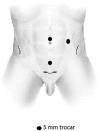Comparison of laparoscopic and microscopic subinguinal varicocelectomy in terms of postoperative scrotal pain
- PMID: 23477168
- PMCID: PMC3481232
- DOI: 10.4293/108680812x13427982376220
Comparison of laparoscopic and microscopic subinguinal varicocelectomy in terms of postoperative scrotal pain
Abstract
Background and objectives: In this study, 2 different varicocelectomy methods were compared with regard to postoperative scrotal pain, length of operation, and complications.
Methods: Forty varicocele patients, who visited our clinic because of infertility or scrotal pain between 2008 and 2009, were enrolled in this clinical study. Microscopic subinguinal varicocelectomy was performed on 20 patients in Group I, and laparoscopic varicocelectomy was performed on 20 patients in Group II. Following surgery, the patients were assessed for postoperative requirements for analgesia; return to normal activity; varicocele recurrence; hydrocele formation; scrotal pain at postoperative days 1, 3, and 7; and other complications.
Results: Mean age was 24.2 +/- 3.4 years in Group I and 25.1 +/- 2.1 years in Group II. Mean pain scores at postoperative 1, 3, and 7 days in Group I were (5.20 +/- 1.14, 4.60 +/- 0.97, and 3.50 +/- 0.97, respectively) significantly higher than those of Group II (0.70 +/- 0.82, 0.60 +/- 0.84, and 0.10 +/- 0.32, respectively). Time to return to normal activity was significantly shorter in Group II (3.7 +/- 2.1 days) compared with Group I (6.8 +/- 3.4 days) (p = 0.028). However, the number of recurrences and hydroceles, as a complication of varicocelectomy, was 2 times higher in Group II (10%) than in Group I (5%).
Conclusions: We believe that laparoscopic varicocelectomy is a safe, effective, and minimally invasive procedure. Furthermore, reduced postoperative discomfort and earlier return to normal activity are additional advantages of this method.
Figures
Similar articles
-
Retroperitoneal high ligation versus subinguinal varicocelectomy: Effectiveness of two different varicocelectomy techniques on the treatment of painful varicocele.Andrologia. 2019 Aug;51(7):e13293. doi: 10.1111/and.13293. Epub 2019 Apr 17. Andrologia. 2019. PMID: 30995701
-
Laparoscopic varicocelectomy in the management of chronic scrotal pain.JSLS. 2014 Jul-Sep;18(3):e2014.00302. doi: 10.4293/JSLS.2014.00302. JSLS. 2014. PMID: 25392634 Free PMC article.
-
Minimal invasiveness and effectivity of subinguinal microscopic varicocelectomy: a comparative study with retroperitoneal high and laparoscopic approaches.Int J Urol. 2005 Oct;12(10):892-8. doi: 10.1111/j.1442-2042.2005.01142.x. Int J Urol. 2005. PMID: 16323983
-
[Factors influencing the postoperative resolution of varicocele-associated scrotal pain].Zhonghua Nan Ke Xue. 2017 Jun;23(6):550-560. Zhonghua Nan Ke Xue. 2017. PMID: 29722949 Review. Chinese.
-
Treatment of palpable varicocele in infertile men: a meta-analysis to define the best technique.J Androl. 2009 Jan-Feb;30(1):33-40. doi: 10.2164/jandrol.108.005967. Epub 2008 Sep 4. J Androl. 2009. PMID: 18772487 Review.
Cited by
-
Outcomes following inguinal and subinguinal urologic procedures under deep intravenous sedation.Can Urol Assoc J. 2024 Oct;18(10):335-340. doi: 10.5489/cuaj.8841. Can Urol Assoc J. 2024. PMID: 38896478 Free PMC article.
-
How Can We Predict a Successful Outcome after Varicocelectomy in Painful Varicocele Patients? An Updated Meta-Analysis.World J Mens Health. 2021 Oct;39(4):645-653. doi: 10.5534/wjmh.190112. Epub 2019 Dec 3. World J Mens Health. 2021. PMID: 32009313 Free PMC article.
-
Who will benefit from surgical repair for painful varicocele: a meta-analysis.Int Urol Nephrol. 2016 Jul;48(7):1071-8. doi: 10.1007/s11255-016-1246-7. Epub 2016 Apr 13. Int Urol Nephrol. 2016. PMID: 27074742 Review.
-
Varicocele management for infertility and pain: A systematic review.Arab J Urol. 2017 Dec 14;16(1):157-170. doi: 10.1016/j.aju.2017.11.003. eCollection 2018 Mar. Arab J Urol. 2017. PMID: 29713547 Free PMC article. Review.
-
Does the number of veins ligated during microsurgical subinguinal varicocelectomy impact improvement in pain post-surgery?Transl Androl Urol. 2017 Apr;6(2):264-270. doi: 10.21037/tau.2017.03.56. Transl Androl Urol. 2017. PMID: 28540234 Free PMC article.
References
-
- Witt MA, Lipshultz LI. Varicocele: a progressive or static lesion? Urology. 1993;59:613–616 - PubMed
-
- Zini A, Girardi SK, Goldstein M. Varicocele. In: Wayne J.G. Hellstrom, ed. Male Infertility and Sexual Dysfunction. New York: Springer-Verlag; 1997;201–218
-
- Madgar I, Weeissenberg R, Lunenfeld B, Karasik A, Goldwasser B. Controlled trial of high spermatic vein ligation for variocele in infertile men. Fertil Steril. 1995;63:120–124 - PubMed
-
- Goldestein M, Gilbert BR, Dicker AP, Dwosh J, Gnecco C. Microsurgical inguinal varicocelectomy with delivery of the testis: An artery and lymphatic sparing technique. J Urol. 1992;148:1808–1811 - PubMed
-
- Hassan JM, Adams MC, Pope JC, Demarco RT, Brock JW. Hydrocele formation following laparoscopic varicocelectomy. J Urol. 2006;175:1076–1079 - PubMed
Publication types
MeSH terms
LinkOut - more resources
Full Text Sources


